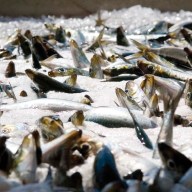“Jam is the new knitting,” jokes Rachel Saunders, founder of Bay Area jam company Blue Chair Fruit, on how everything artisanal, like preserving, is taking off.
Saunders’ love for making jam, however, started over 10 years ago, when not only was the craft un-trendy, but there were hardly any modern cookbooks explaining how to make it. And though the New York native taught herself from old tomes like “Joy of Cooking,” you don’t have to. Her new work, “The Blue Chair Jam Cookbook,” filled with 120 inventive recipes, gorgeous photography and seasonal, sustainable methods, takes a modern approach to this lost art.
“People think of jam in a stodgy, grandma way,” says Saunders. “I want to throw the door open and let some fresh air in.”
Testing for doneness
Knowing when the jam is done cooking is the hardest part of the process, warns Saunders: “If you screw that up, your batch is irretrievable.” To help you not screw up, she includes clear, step-by-step images in the book that illustrate what a finished batch looks like.
Keeping things simple, Saunders prefers the freezer test over a candy thermometer. For this technique: Stick five spoons in the freezer. When you think your preserve is cooked, take one frozen spoon out and put half a spoonful of your jam mixture on it. Stick it back in the freezer for three minutes. Remove and tilt the spoon to see if your concoction is too runny.
RECIPE: Grown-Up Strawberry Jam
This deliciously sophisticated cocktail of a strawberry jam takes the flavor of the berries a step beyond the simple flavors of childhood. The hard-to-place flavor of Drambuie liqueur lends the fruit an unexpectedly herby flavor. This sparkling jam reminds me of warm evenings spent on the back porch, slowly sipping a tall drink and listening to the evening crickets: summer in a jar.
3 pounds 14 ounces hulled strawberries
2 1/2 pounds white cane sugar
4 ounces plus 2 ounces strained freshly squeezed lemon juice
2 1/2 ounces Drambuie
Place a saucer with five metal teaspoons in a flat place in your freezer for testing the jam later.
In an 11- or 12-quart copper preserving pan or a wide nonreactive kettle, combine the berries with the sugar and 4 ounces of the lemon juice. Place the pan over medium-low heat and cook, stirring constantly with a heatproof rubber spatula. After a few minutes, as the juice starts to run and the mixture begins foaming a little around the edges, gradually raise the heat to high, stirring often.
Boil the mixture vigorously for 20 to 30 minutes, gently scraping the bottom of the pan every few minutes with your spatula to be sure the jam is not sticking. If it begins to stick, decrease the heat slightly, being sure the jam continues to cook at a rapid boil. Continue to cook, stirring and scraping the bottom frequently, until the foam subsides, the mixture acquires a darker, shinier look, and the berries appear softened and saturated with liquid, 20 to 25 minutes total.
Remove from the heat. Do not stir. Let the mixture rest for a moment, then use a metal soup spoon to carefully skim all the white foam from the top of the mixture. When you have removed every last bit of white, stir in the remaining 2 ounces of lemon juice and the Drambuie. Return the jam to medium or medium-low heat and continue to cook, stirring frequently. If necessary, gradually lower the heat to prevent scorching.
After 3 to 5 more minutes, your jam should again look glossy and dark. At this point, remove from the heat and test for doneness. Do not stir. To test for doneness, carefully transfer a small representative half-spoonful of jam to one of your frozen spoons.
Replace the spoon in the freezer for 3 to 4 minutes, then remove and carefully feel the underside of the spoon. It should be neither warm nor cold; if still warm, return it to the freezer for a moment. Tilt the spoon vertically to see how quickly the jam runs; if it runs slowly, and if it has thickened to a gloppy consistency, it is done. If it runs very quickly or appears watery, cook it for another couple of minutes, stirring, and test again as needed. This jam, while spreadable, has a relatively loose texture.
—From The Blue Chair Jam Cookbook by Rachel Saunders/Andrews McMeel Publishing
















